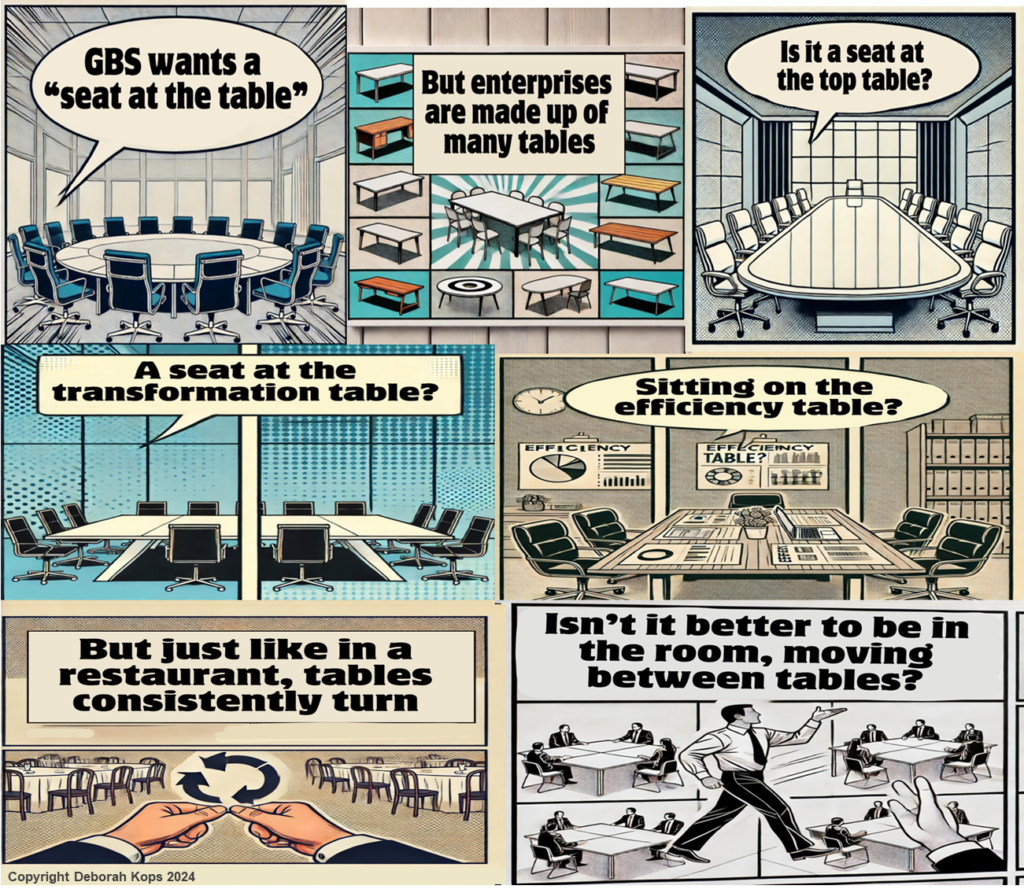Blog
If You Don’t Have a Seat at the Table, Are You on the Menu?

I recently took one of those unplug-and-unwind holidays but made it only eight days before I craved a serious conversation. So I rang my good friend, the always-wise Fred Simoes of Cargill, for some food for thought. When we got to talking about enterprise GBS strategy, he popped a quote I’d somehow missed attributed to US Representative Shirley Chisholm, “If you don’t have a seat at the table, you are probably on the menu.” It got me thinking about how a GBS seat at the table actually manifests itself. (By the way, thanks, Fred, for giving me a new topic to obsess about).
Seat at the table, seat at the table. Most industry reports and surveys proudly proclaim that global business services organizations increasingly have been invited to rub shoulders with the C-suite, influencing strategy, yucking it up with the enterprise’s CXOs, and ensuring that GBS is embedded in the operating model.
But if I take sitting at the top table literally, looking around me, I see only a handful (ok, maybe two hands on a good day) of GBS leaders who are badged as CXOs. If so few actually have a physical seat at the table, do we have an aspiration that is inaccurate, misleading, and frankly, not usually within a GBS leader’s reach?
Given the paucity of leaders on the same reporting line as the CFO or part of the EXCO, what does the phrase “seat at the table” actually mean for GBS and their leaders? And how important is it?
According to the Free Dictionary, the font of much knowledge, it means an “active role in some group or activity in which one’s opinions are heard, and one has influence in how decisions are made.”
So I did a bit of thinking about the term and came to the conclusion we have it all wrong. There are many tables in an enterprise—think transformation table, efficiency table, cost-cutting table, even growth table—and at any given time, it’s critical that GBS sit at some or all of them.
Perhaps it’s more important that GBS is always in the room, moving between tables. Comfortably seated at one table is a risk when corporate priorities and personnel are constantly changing, just like tables in a restaurant.
Given this definition, how do you know your GBS is in the room? Looking around, I see these markers:
- Documented as a vital pillar of corporate strategy
- Pervasive in the transformation agenda
- Considered in all pertinent enterprise decisions
- Actively sought out by CXOs and the business for advice and counsel
- Has the agility and flexibility to pivot the model quickly as business conditions change
- Career paths in and out of GBS
How do you know your GBS is standing in the hallway, knocking at a door that just won’t open?
- Relegated to focusing exclusively on cost
- Reporting line is continually tossed around between stakeholders
- Ebbing and flowing scope
- Can’t get a conversation with the CEO for love or money
- Not perceived as a source of capability
- Continually “rebooting”
The obvious question is—how does GBS get into the room? Here’s how I see it.
- Create tangible, quantifiable value, not vaporware
- Move the enterprise to the model at the speed it can absorb but at a pace that creates impact
- Be seen as a partner problem solver, not a blocker
- Able to work effectively with a number of enterprise constituencies
Knows when to retreat to advance
So, Fred, I certainly get what the quote originally inferred…not being at the table can mean that you become someone’s delicious dinner. But, perhaps GBS organizations need to rethink their ambition, and make sure they are always in the room.